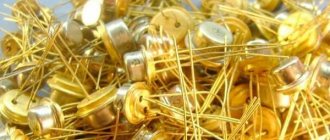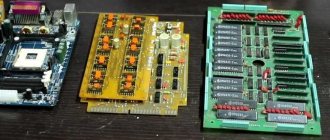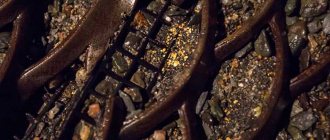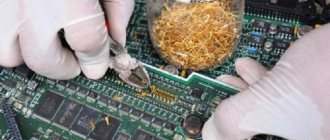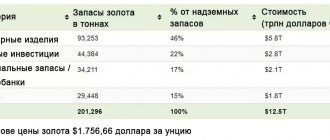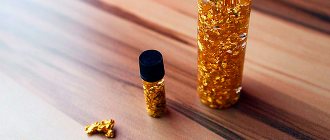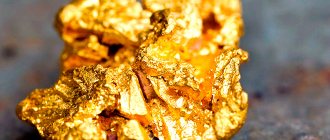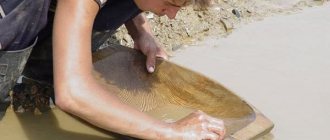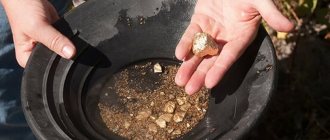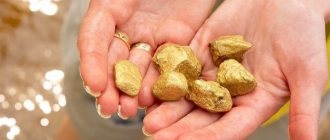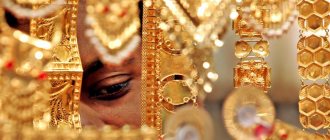Radio components containing gold
Gold-bearing deposits are developed if the content of the precious element is at least 1 gram per ton of rock. In one chip there is from 1 to 5 percent yellow metal. The leads of the part, enclosed in a ceramic case, are coated with gold.
If it is made of plastic, the content of valuable raw materials is less - from 0.2 to 1 percent. In transistors, the precious element is about 2 percent. The substrate located under the conductor is made of gold.
But capacitors break all records. Their size is approximately equal to a three-liter jar. One such part contains approximately 8 grams of yellow metal. In addition, there is also 50 grams of silver. However, only capacitors used in military equipment - generators and radio signal transmission stations - are equipped with expensive filling.
Some gold can also be extracted from radio tubes. The precious element is deposited on a grid located near the cathode. The latter, when the lamp is operating, heats the grid. When exposed to heat, it begins to release electrons. This disrupts the operation of the product.
Therefore, the radio component needs to be coated with gold . Spraying from it is also found on the legs of objects of consecration, but this only applies to old samples, decades old.
Several microns of precious raw materials were previously applied to connectors of all types of semiconductors, such as diodes, optocouplers, thyristors, and zener diodes. Gold is rarely found in resistors. However, some of them, along with silver, also contain a little yellow metal.
These are the standards by which radio components were manufactured in the USSR in the 70s and 80s of the last century. Gold is also found in modern radio components . However, it is impractical to extract hundredths of a gram from an item for which tens, or even hundreds of thousands of rubles were paid. Let the old parts be used - that's another matter.
Most often, radio components containing gold are found in old-style computers, switching devices, and radio equipment. Electronic computing units of the SM and CE series should be of primary interest to applicants. One such machine contains from 0.2 to 10 kilograms of gold. Some military equipment can boast of the same thing.
Beginners will find it useful to list not only the general names of radio components equipped with gold “filling,” but also specific model designations. So:
Transistors KT201, KT203, KT3102, KT301, KT306, KT605. All of them are equipped with golden colored legs.
KT802, 808, 803, 809, 812, 908. We need samples produced before 1986. In later models gold was not used.
KT907,904, 606. Externally they have no gold elements and no yellow color. However, valuable raw materials are actually present.
But KT602, 604, 611, 814, 815, 816, 9909 have gold cases.
Relay RES9, 10, 15, 22, 34, RPS24, 32, 34, RKG15.
Microcircuits K142EH, K50, K56PY2, AOT101, K145, also known as the “white spider”.
Chips K133, 134, 178, 249, 564, 565, K140, 157, 217.
Diodes of the D226 series and similar ones.
Capacitors Km3, 4, 5, 6, 10, 11, 12, 13, 14, 15, 16, 17, 52-1, 52-7, K53-1, 53-6, 53-7, 53-10, 53 -15, 53-16.
Resistors PTP1, 2, PLP2, 6, PP3-40, 3-41, 3-43, 3-44, 3-45, 3-47, KSP1, 4, KSU1, KSD1, KPU1, KPP1, SP5-1, 5 -2, 5-3, 5-4, 5-14,5-15, 5-16, 5-17, SP3-19, 3-44.
Connectors SNP59-64V, SNP59-96R, GRPPM7-90Sh, RPPG2-48.
Switches TV1, P23G, Pg2-5, 2-6, 2-7, 2-10, P1T3-1V, PR2-10, PKN8, PT33-26, PP8-6, PPK2.
Which radio components contain precious metals?
Precious metals contain many radio components, including:
connectors;- microcircuits;
- transistors;
- diodes;
- relay;
- capacitors;
- resistors;
- circuit breakers;
- radio tubes.
Of course, precious metals are not contained in all connectors, microcircuits and other radio components, but only in some types. Even in identical parts that contain precious metals, their quantity can vary greatly and depends on the year of manufacture. That is why radio components have different values, which directly depend on the content of precious metals in them.
The main value in this regard is Soviet-era electronics, namely computer blocks and various military equipment. For example, in the once famous EC series computers, the content of precious metals can range from several hundred grams to 10 or more kilograms! Considering the current cost of gold and silver, disassembling and handing over this electronic equipment to a specialized company can bring more than significant income.
Approximately half of all gold and silver used in electronics production was spent on contacts and connectors. These precious metals provide very high-quality contact, which is why they are widely used. Typically, the contact base was made of copper or brass alloy; only the contact pads themselves were made of precious metal.
The rest of the gold and silver is found in microcircuits, transistors, variable resistors and other electronic components. Precious metals such as platinum and palladium are mainly found in ceramic capacitors.
Some radio tubes contain a large amount of gold - for example, the GMI-19 lamp contains as much as 16 grams of gold! Many other radio tubes also contain gold, silver and platinum, but the amount of precious metals in them is usually quite small and usually amounts to thousandths, less often hundredths or tenths of a gram.
Extraction of precious metals from radio components
The content of precious metals in radio components is, as a rule, low, which significantly complicates their extraction. Only in rare cases is it possible to directly extract precious metal from an electronic component - for example, by biting off gold or silver contacts. It is impossible to extract precious metals from microcircuits, transistors, diodes and other electronic components in the same way.
That is why, in the vast majority of cases, precious metals are extracted from electronic components at specialized enterprises that have the necessary equipment and technologies. At the same time, raw materials are supplied to enterprises in an already prepared state, sorted into specific groups.
The finished raw material goes through several stages of physical and chemical processing, during which the concentration and release of precious metals occurs. All these processes are quite complex, so they are almost impossible to carry out independently at home. In addition, large volumes of raw materials are required, which are very, very difficult for a private individual to collect.
Taking into account the complexity of separating precious metals from radio components, this work should be carried out only at specialized enterprises. If you have old radio components that contain precious metals, your best bet is to hand them over to companies that collect and recycle electronic components. In particular, you can always contact us.
How to extract gold from radio components
Let's try to figure out how to extract gold from radio components . The solvent for the precious metal is a mixture of hydrochloric and sulfuric acids. The proportions are 3 to 1, respectively. Liquids of a certain density must be mixed.
The indicator of sulfuric acid should be 1.8 grams per cubic centimeter, hydrochloric acid - 1.19 grams per cubic centimeter. The separation of gold from the base will not be complete unless the solution is heated to 60, 70 degrees Celsius.
Only the part should be lowered into the hot mixture. Afterwards, add a small amount of nitric acid to the container. The resulting solution is known as “aqua regia.” It dissolves almost all elements, including gold. The microcircuit, or other element, will melt in the mixture, which should then be precipitated with a reducing agent.
The number of radio components and the content of valuable raw materials in them should be taken into account. Typically, 200–300 grams of gold-plated surface requires one and a half liters of nitric acid. The equipment should be disassembled as much as possible, glass elements and areas without precious coating should be separated.
They will “take” the chemical solution onto themselves, and then more of it will be needed. It is advisable to lower only the parts themselves with yellow metal into the medium.
At room temperature, without heating, metal can be isolated from a mixture of acids by electrolysis. It is only suitable for working with copper and brass parts. A current with a density of 0.1 to 1 A/dm2 is passed through the solution. Lead or iron is used as the cathode. The gold separation procedure is completed if the current strength begins to drop sharply.
You can buy ready-made compositions for separating precious metals in special stores. It is also possible to establish cooperation with small chemical industry enterprises. Many Internet sites also offer reagents and deliver products to your home. The methods for extracting gold from radio components described above are applicable at home.
What radio components are rich in palladium?
Nowadays, the cost of palladium is enormous. A gram of palladium costs almost twice as much as gold - 5,900 rubles. Therefore, extracting palladium from radio components is extremely profitable. Moreover, this metal does not dissolve in sulfuric and hydrochloric acids, so it can be obtained from Soviet radio components using acids - quickly and efficiently.
Experts have long noticed the precious metal palladium in radio components of Soviet electronics. This metal was actively used in the production of computers and in the manufacture of televisions; there is also a lot of this extremely expensive metal in special-purpose equipment - measuring instruments, sensors, and military equipment.
Sell
Palladium lamellas are present in most samples of Soviet computers. Computers made in the USSR can contain up to ten grams of this valuable metal. It is also worth noting the presence of PP-3 resistors, in which palladium is found in abundance in the contacts. Moreover, as experts point out, resistor contacts are rich in 80 percent palladium.
In standard Soviet TVs “Horizon”, “Rubin”, “KVN”, “Sapphire”, “Electronics” the precious metal palladium was present in small quantities. Palladium was most often deposited on CM capacitors in a very thin layer.
The older the equipment, the richer it is in radio components containing precious metals. One PTU-58 TV contains 120 grams of pure silver and almost 15 grams of gold. Palladium, along with platinum, were actively used as contacts in old Soviet technology, along with silver. Prices for precious metals back then were still completely different than they are now.
Costs of separating gold from radio components
One liter of reagents costs approximately 300 rubles. 1 gram of isolated gold is valued at approximately 2500-3000 rubles. To get about 3 grams of yellow metal from KT605 transistors, for example, you will need 100 parts. Each of them contains 27 micrograms of valuable raw materials.
You can buy transistors for 15-20 rubles apiece. Spend about 2000 rubles, you will receive approximately 8000-9000 thousand. It is necessary to calculate the profitability of an enterprise. “Recycling” of some radio components is unprofitable.
LLC "DRAGOMIR" - purchase of radio components at competitive prices
Our company accepts electronic scrap at competitive prices. We guarantee you fast processing of the radio components you brought or sent and payment of the remuneration due to you. You will find information about the specific types of radio components we accept on the corresponding pages of our website.
Working with us is profitable and convenient; we receive radio components in the following cities:
- Ekaterinburg;
- Tyumen;
- Chelyabinsk;
- Permian;
- Vladivostok;
- Krasnodar;
- Barnaul.
You can contact any of our offices or send radio components by mail, payment is guaranteed. Don't miss the opportunity to earn very substantial money quickly and without hassle. Contact us right now!
Content of precious metals in the D226B diode
Soviet D226B diodes are in demand among radio scrap buyers for their content of precious metals (DGM). Interest in them is fueled by disputes regarding the presence of gold and silver inside. Numerous sources in the form of reference books, product passports and accompanying labels do not provide complete information about this, since the data indicated in them varies.
The most typical DGM values in Soviet d226b are considered to be:
- gold 2.5857 mg;
- silver 0.5579 mg;
- platinum and palladium – 0 mg.
Taken from old datasheets for the device
The same information is presented in the technical description from “Photon”, Tashkent, Uzbekistan. However, since 1990, the same plant has limited its documentation to the phrase “the product does not contain precious metals.” Modern Russian manufacturers have no data at all.
The exact quantity and content of precious metals in d226b is quite difficult to estimate, especially if they were produced at different times and at different enterprises. It is known that the initial batches had worse characteristics, but they contained more precious metal. For example, if you open diodes from the first years of production (before 1971), you will find gold plating on the inside of the round cap. In later versions it is not visible.
According to some information, the gold and silver of the diode in question may be in the solder with which the crystal is attached to the round substrate. Since the latter is a nickel-iron-copper alloy, it is very difficult to etch the precious metal out of it at home. At the same time, this process will not be a problem for modern smelters processing radio scrap.
Some craftsmen, having collected products from different years of production and manufacturing plants, extract small amounts of gold from them chemically. In most cases, the results of such work are not satisfactory and the costs are not recouped. About 0.3-0.4 grams of yellow metal is obtained as a result of refining 1000 such devices. An example of such an experiment can be seen in the video.
It is worth noting that there are d226b in which the content of precious metals is unconditional, and their price as scrap will be higher for buyers. We are talking about products for military needs that underwent additional testing before release. On the body of such products (before 1975) there are usually the symbols “VP”, and a little later an additional diamond or asterisk. It is believed that the quality and composition of materials for their manufacture did not change until 1992. But in the latest versions, DGMs are most likely absent, so their cost does not exceed 70-100 rubles. for 1 kg.
